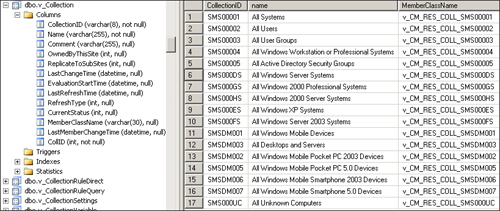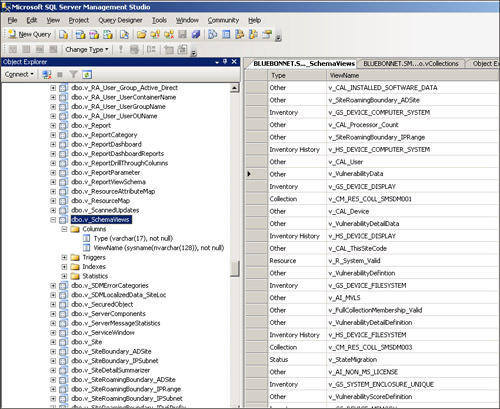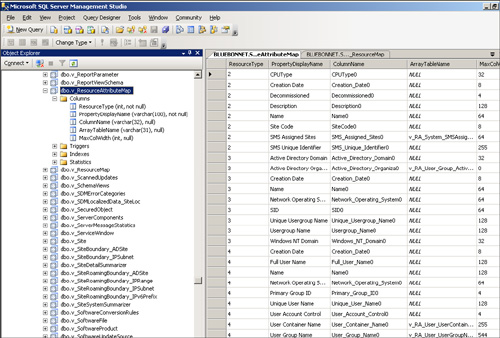The Configuration Manager site database is a SQL
Server database that contains data about your ConfigMgr infrastructure
and objects, the client systems you manage, and other discovered
resources. The default name of the site database is SMS_<Site Code> (where <Site Code>
indicates the primary site the database is associated with). Although
the exact number of objects in a ConfigMgr site database varies, there
are generally several thousand objects. Management applications,
including the Configuration Manager console, use WMI to access the
database.
SQL Access to the Database
Microsoft’s
Configuration Manager developers provide an extensive set of database
views that present the underlying data tables in a consistent way. The
views abstract away many of the details of the underlying table
structure, which may change with future product releases. In some cases,
ConfigMgr uses stored procedures in place of views to retrieve data
from the tables. The reports in Configuration Manager use SQL views.You can
use the views to understand the internal structure of the database. The
next sections present a subset of these views and provide information
about how the views are organized and named.
Most of the
Configuration Manager SQL views correspond to ConfigMgr WMI classes. In
many cases, the views also reflect the underlying table structure, with
minor formatting changes and more meaningful field names.
Most ConfigMgr
administration tasks do not require you to work directly with SQL
statements. One Configuration Manager component—ConfigMgr
reporting—allows you to directly supply native SQL statements that
access the site database. The ConfigMgr console also allows you to
create and schedule SQL database maintenance tasks.
Using SQL Server Management Studio
The primary user
interface for administering SQL Server 2005 is the SQL Server Management
Studio. To access the Configuration Manager views, perform the
following steps:
1. | Launch
the SQL Server Management Studio from Start -> Programs ->
Microsoft SQL Server 2005 -> SQL Server Management Studio.
|
2. | After connecting to the site database server SQL instance, expand <servername>\database\SMS_<Site Code>\views in the tree control in the left pane.
|
Viewing Collections
The Collections WMI object provides access to the properties and
methods of the Configuration Manager collections defined in the site
database. The SQL view v_Collections provides access to much of the same
data. Figure 1
shows the tree control expanded in the left pane to display the column
definitions for v_Collections, whereas the view on the right displays
some of the column values visible when opening the view. These columns
correspond to the SMS_Collection WMI class properties, .
Notice that the MemberClassName column provides the name of the view
for the collection membership. These views correspond to the WMI objects
specified in the MemberClassName property of the SMS_Collection WMI
class.

The
v_Collection view is one of several views referencing Configuration
Manager objects. Similar views include v_Advertisement, v_Package, and
v_Report. The naming conventions for views generally map to the
corresponding WMI classes, according to the following rules:
- WMI class names begin with SMS_, and SQL view names begin with v or v_.
- View names over 30 characters are truncated.
- The WMI property names are the same as the field names in the SQL views.
Site Properties
Basic
Configuration Manager site properties are stored in the Sites table and
exposed though several views and stored procedures. As an example,
v_site displays the basic configuration of the current site and its
child sites. The sysreslist table stores information about the site
systems. An example of a stored procedure that retrieves data from the
sites and sysreslist tables is MP_GetMPListForSite, which displays
management point information for the site. The SMSData table includes
additional site details, exposed through v_identification.
The tables and views
discussed so far relate to the Configuration Manager objects and
infrastructure. The database also contains a wealth of data gathered by
various discovery methods and client inventory. Discovery and inventory data is
stored in resource tables and presented in resource views. The naming
conventions for resource views are as follows:
Views displaying current inventory data are named v_GS_<group name>.
Views displaying inventory history data are named v_HS_<group name>.
Views containing discovery data are named v_R_<resource type name> for data contained in WMI scalar properties and v_RA_<architecture name>_<group name> for data contained in WMI array properties.
Inventory data for custom architectures is presented in views named v_G<resource type number>_<group name> and v_H<resource type number>_<group name>.
Other Views
Several views are
included that present metadata on other views and serve as keys to
understanding the view schema. The v_SchemaViews view, displayed in Figure 2, lists the views in the view schema family and shows the type of each view.

The following SQL statement generates the V_SchemaViews view:
CREATE VIEW [dbo].[v_SchemaViews] As SELECT CASE
WHEN name like 'v[_]RA[_]%' THEN 'Resource Array'
WHEN name like 'v[_]R[_]%' THEN 'Resource'
WHEN name like 'v[_]HS[_]%' THEN 'Inventory History'
WHEN name like 'v[_]GS[_]%' THEN 'Inventory'
WHEN name like 'v[_]CM[_]%' THEN 'Collection'
WHEN name like '%Summ%' THEN 'Status Summarizer'
WHEN name like '%Stat%' THEN 'Status'
WHEN name like '%Permission%' THEN 'Security'
WHEN name like '%Secured%' THEN 'Security'
WHEN name like '%Map%' THEN 'Schema'
WHEN name = 'v_SchemaViews' THEN 'Schema'
ELSE 'Other'
END
As 'Type', name As 'ViewName'
FROM sysobjects
WHERE type='V' AND name like 'v[_]%'
If you examine the SQL statement, you can see that the selection criteria in the CASE statement use the naming conventions to determine the type of each view.
The v_ResourceMap view
presents data from the DiscoveryArchitectures table, which defines the
views representing discovery data. Table 2 displays the data provided by the v_ResourceMap view.
Table 2. The v_ResourceMap View
| ResourceType | DisplayName | ResourceClassName |
|---|
| 2 | Unknown System | v_R_UnknownSystem |
| 3 | User Group | v_R_UserGroup |
| 4 | User | v_R_User |
| 5 | System | v_R_System |
| 6 | IP Network | v_R_IPNetwork |
ConfigMgr uses the fields in Table 3.3 in the following manner:
The
ResourceType field is the key used throughout the resource views to
associate resources with the appropriate discovery architecture.
The DisplayName field is a descriptive name of the discovery architecture.
The
ResourceClassName indicates the view that contains basic identifying
information for each discovered instance of the architecture.
As an example, the
v_R_System view provides the unique Resource ID of each computer system
discovered by Configuration Manager as well as basic system properties
such as the NetBIOS name, operating system, and AD domain. Each resource
view containing system information includes the Resource ID field,
allowing you to link resources such as hard drives and network cards
with the system to which they belong.
The v_ResourceAttributeMap view displayed in Figure 3 presents resource attribute types extracted from discovery property definition data in the DiscPropertyDefs table.

Tip: Column Names Have a “0” Appended
The ConfigMgr development team appends the column names with “0” to avoid possible conflicts with SQL reserved words.
The v_GroupMap view lists the inventory groups and views associated with each inventory architecture. Table 3
displays some v_GroupMap entries. Each inventory architecture
represents a WMI class specified for inventory collection in the
SMS_Def.mof file.
Table 3. The v_ GroupMap View (Partial Listing)
| Resource Type | GroupID | DisplayName | InvClassName | InvHistoryClassName | MIFClass |
|---|
| 5 | 1 | System | v_GS_SYSTEM | v_HS_SYSTEM | SYSTEM |
| 5 | 2 | Workstation Status | v_GS_WORKSTATION_STATUS | | MICROSOFT|WORKSTATION_STATUS|1.0 |
| 5 | 3 | CCM_RecentlyUsedApps | v_GS_CCM_RECENTLY_USED_APPS | | MICROSOFT|CCM_RECENTLY_USED_APPS|1.0 |
| 5 | 41 | Add Remove Programs | v_GS_ADD_REMOVE_PROGRAMS | v_HS_ADD_REMOVE_PROGRAMS | MICROSOFT|ADD_REMOVE_PROGRAMS|1.0 |
| 5 | 42 | Add Remove Programs (64) | v_GS_ADD_REMOVE_PROGRAMS_64 | v_HS_ADD_REMOVE_PROGRAMS_64 | MICROSOFT|ADD_REMOVE_PROGRAMS_64|1.0 |
| 5 | 43 | BIOS | v_GS_PC_BIOS | v_HS_PC_BIOS | MICROSOFT|PC_BIOS|1.0 |
| 5 | 44 | CD-ROM | v_GS_CDROM | v_HS_CDROM | MICROSOFT|CDROM|1.0 |
| 5 | 45 | Computer System | v_GS_COMPUTER_SYSTEM | v_HS_COMPUTER_SYSTEM | MICROSOFT|COMPUTER_SYSTEM|1.0 |
| 5 | 46 | Disk | v_GS_DISK | v_HS_DISK | MICROSOFT|DISK|1.0 |
| 5 | 47 | Partition | v_GS_PARTITION | v_HS_PARTITION | MICROSOFT|PARTITION|1.0 |
| 5 | 48 | Logical Disk | v_GS_LOGICAL_DISK | v_HS_LOGICAL_DISK | MICROSOFT|LOGICAL_DISK|1.0 |
Each entry in Table 3.4
specifies the resource type, a unique GroupID, the inventory and
inventory history views that present the group data, and the Management
Information Format (MIF) class from which the inventory data for the
group is derived.
The
v_GroupAttributeMap lists the attributes associated with each inventory
group, and the v_ReportViewSchema view provides a list of all classes
and properties.
This section examined
several of the SQL views Microsoft provides. You can learn a lot about
the internal structure of ConfigMgr by using the SQL Server Management
Studio to explore the database on your own. You may want to look at the
views, the underlying tables, and some of the stored procedures
ConfigMgr uses. The examples in this section show how you can analyze
and understand these objects.
Caution: Do Not Modify the Site Database Directly
The
site database is critical to the functioning of your site. Do not
attempt to create, delete, or modify any database objects, or to modify
data stored in the database, unless asked to do so by Microsoft support
personnel. Remember to test all modifications before applying them to
your production environment.